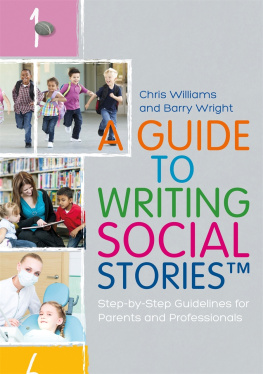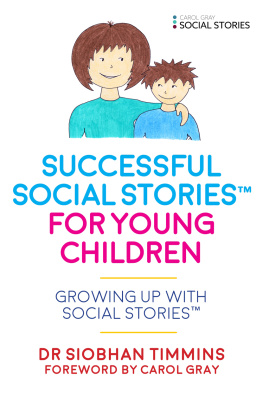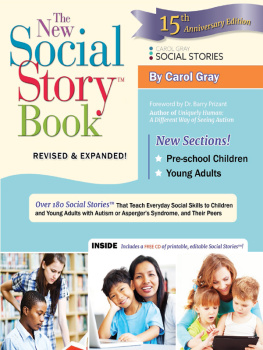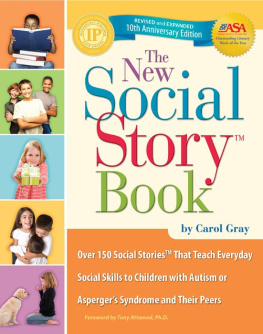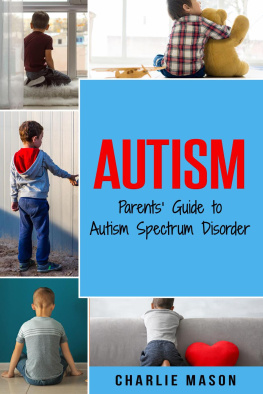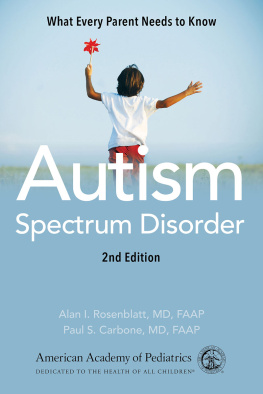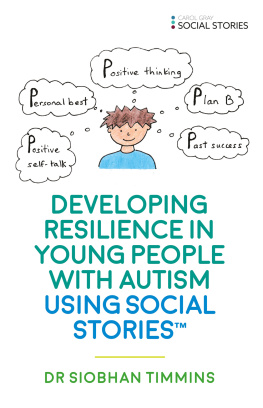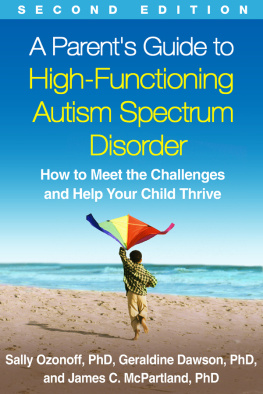Williams Chris - A Guide to Writing Social Stories (tm)
Here you can read online Williams Chris - A Guide to Writing Social Stories (tm) full text of the book (entire story) in english for free. Download pdf and epub, get meaning, cover and reviews about this ebook. year: 2016, publisher: Jessica Kingsley Publishers, genre: Children. Description of the work, (preface) as well as reviews are available. Best literature library LitArk.com created for fans of good reading and offers a wide selection of genres:
Romance novel
Science fiction
Adventure
Detective
Science
History
Home and family
Prose
Art
Politics
Computer
Non-fiction
Religion
Business
Children
Humor
Choose a favorite category and find really read worthwhile books. Enjoy immersion in the world of imagination, feel the emotions of the characters or learn something new for yourself, make an fascinating discovery.
- Book:A Guide to Writing Social Stories (tm)
- Author:
- Publisher:Jessica Kingsley Publishers
- Genre:
- Year:2016
- Rating:4 / 5
- Favourites:Add to favourites
- Your mark:
- 80
- 1
- 2
- 3
- 4
- 5
A Guide to Writing Social Stories (tm): summary, description and annotation
We offer to read an annotation, description, summary or preface (depends on what the author of the book "A Guide to Writing Social Stories (tm)" wrote himself). If you haven't found the necessary information about the book — write in the comments, we will try to find it.
A Guide to Writing Social Stories (tm) — read online for free the complete book (whole text) full work
Below is the text of the book, divided by pages. System saving the place of the last page read, allows you to conveniently read the book "A Guide to Writing Social Stories (tm)" online for free, without having to search again every time where you left off. Put a bookmark, and you can go to the page where you finished reading at any time.
Font size:
Interval:
Bookmark:

A GUIDE
TO
WRITING
SOCIAL
STORIES TM
Step-by-Step Guidelines for
Parents and Professionals
Chris Williams
and Barry Wright

Jessica Kingsley Publishers
London and Philadelphia
CONTENTS
FOREWORD: A PARENTS VIEW
As a parent of a child with autism, I am proud to have been involved in workshops to inform the writing of this guide. My first thought is that all children are unique, and this book respects that vision, providing a clear and easy-to-use guide to Carol Grays Social Stories.
Every young person is special, with a unique combination of abilities and needs which affect learning. All young people deserve the opportunity to learn in ways that make the most of their strengths. Children with autism and Asperger syndrome are individuals with their own hopes, likes and dislikes, skills, interests and passions.
Young people who have autism (and are aware of this) may be teased and they may draw attention away from it or be under pressure to fit in. We need to make sure that they have the support, understanding and tolerance they deserve.
As adults it is important to think about the young persons ordinary needs for love, closeness, touch, security, fun and laughter, friends, achievement, respect, hope and a sense of being wanted for who they are.
Some thoughts for parents and teachers to consider: are there particular interests or skills that could be turned into a gift? For example, Jack can sometimes be distracted by someone wearing glasses or earrings does he have an eye for detail and notice small differences? Mona spends a lot of time straightening her desk and putting things away is she organised and tidy?
Respect for individual rights and needs is enshrined in law. For example, the Disability Discrimination Act 1995 and the Equality Act 2010 both lay out clear principles in law that all parents, teachers and society at large must follow. It is very important to know this because it will affect the day-to-day work of teachers, and will ensure the needs of children with autism or Asperger syndrome are being met.
This makes sure that young people with autism are not discriminated against. In education, for example, this includes thinking about:
changes to practices or procedures
changes to physical features
changes to how learners are assessed
providing extra support and aids (such as specialist teachers or equipment).
Social Stories can help with this in unseen ways. They are a process that enables us to understand our children better. They prompt us to work together to explore what we can do rather than trying to get the young person with autism to change something that is a result of their impairment.
Used properly, Social Stories are a great force for positive development. This is not just through the Social Story itself but in the empowering process that leads to the Story, the detective work, talking to the child or young person themselves and all those who know them and working together in a supportive alliance. Indeed, as a parent and educationalist, I have found most value in the setting up of Social Stories (including those deemed unsuccessful) in giving me a different perspective of a situation I thought I had understood well.
This guide will help parents, teachers and other adults supporting a child to write and use Social Stories. I commend it to you.
Jo Whitehead (parent)
INTRODUCTION
This guide was written for professionals and parents as a guide to writing Social Stories. It was developed as part of a large research study to evaluate the effectiveness of Social Stories in helping young people with autism and Asperger syndrome in mainstream schools in the United Kingdom (Autism Spectrum Social Stories in Schools Trial (ASSSIST), Wright et al . 2014; Marshall et al. 2016; Wright et al. 2016).
Carol Gray introduced Social Stories over 25 years ago. They have been used widely and are perceived by many to have been one of the most effective ways of helping young people with autism to understand their social environment more successfully. Social Stories provide information about specific social situations in order to increase understanding for children and young people. This often leads to the secondary effect of a Social Story, which is a positive change in the childs life and reduced anxiety and distress.
This guide is based on the 10.2 revised criteria (Gray 2015) and is divided into five parts.
provides information about autism and Asperger syndrome with the aim of helping the reader to understand how young people with autism spectrum disorder (ASD) may see and experience the world they live in. It also includes some of the background to Social Stories and an explanation of why they are particularly relevant in this situation.
takes a step-by-step approach to writing Social Stories with the British audience particularly in mind. This section was written in consultation with parents and teachers who have had experience with using Social Stories in practice and with a great deal of support and advice from Carol Gray. There is a worked example in this section called Taking turns to help in assembly.
contains further examples of the process of writing Social Stories, including how to gather information for the Story.
is a collection of completed Stories written by parents and teachers involved in the study.
contains extra resources including a template for gathering information, a flowchart, some very useful checklists and a list of definitions of terms.
There is a video to accompany this guide, which is a summary of Social Stories as described by Isabel and her mum and one of the authors. It was filmed in 2014. Many thanks to them for sharing their experiences! Go to: https://youtu.be/V1x7i7HfVow
Part 1
SOCIAL STORIES
and Autism
UNDERSTANDING AUTISM
Autism spectrum disorder (ASD) is a developmental disorder that normally becomes evident in the first 3 years of a childs life. It includes autism, Asperger syndrome and atypical autism. ASD affects communication, social interaction, imagination and behaviour. It is not something a child can catch.
Parents do not cause it.
All children with ASD will continue to make developmental progress and there is a great deal that can be done to help. The following sections describe some important theories that help explain it in more detail.
Mindblindness
Children with ASD are delayed in developing Theory of Mind and struggle to learn it intuitively in everyday interactions in the same way other children do. Some books call this mindblindness. Mindblindness refers to being partially blind to understanding the minds of other people. Consequently, people with ASD have great difficulty in understanding the point of view, thoughts or feelings of someone else. Mindblindness leads to great difficulties in making accurate guesses about what people might be thinking or feeling or in predicting what they are going to do. This is a crucial skill for successful social interactions.
Imagine being unable to understand how someone else is thinking or feeling; imagine not being able to consider their point of view. How confusing and frightening the world must seem and how difficult social interactions must be. It is not surprising, therefore, that young people on the autism spectrum are sometimes anxious, see things more from their own point of view and behave differently from other children. This is not the same as selfishness. It is a problem in their understanding of other people.
Mindblindness is not an all or nothing concept. The ability to intuit another persons emotional state varies in people with or without autism. However, in children with autism, this ability is likely to be within a lower range or band and develop at a slower pace.
Next pageFont size:
Interval:
Bookmark:
Similar books «A Guide to Writing Social Stories (tm)»
Look at similar books to A Guide to Writing Social Stories (tm). We have selected literature similar in name and meaning in the hope of providing readers with more options to find new, interesting, not yet read works.
Discussion, reviews of the book A Guide to Writing Social Stories (tm) and just readers' own opinions. Leave your comments, write what you think about the work, its meaning or the main characters. Specify what exactly you liked and what you didn't like, and why you think so.

